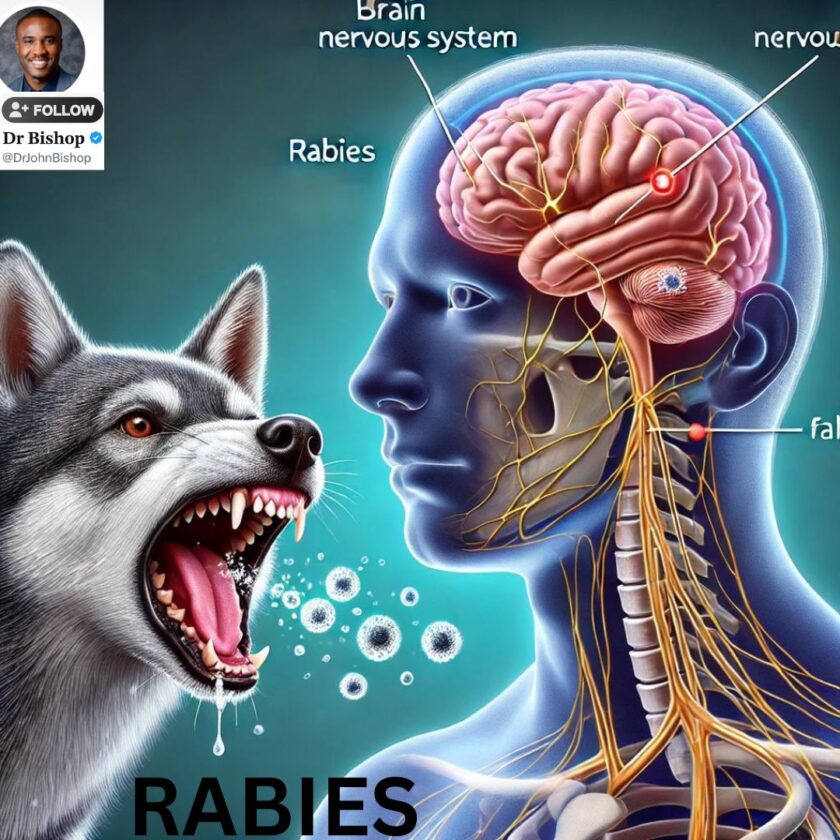So many persons, especially in Africa may not understand fully the dangers of getting bitten by a rabid infested dog.
This thread carefully written by @DrJohnBishop explains it all….. Read and learn…
“Today, I saw a video of a child with rabies and it broke my heart. I felt this was an opportunity for awareness on the topic. So, let’s talk about rabies – a disease that’s as terrifying as it is preventable.
Rabies is a viral infection that primarily affects mammals, including humans, and is almost always fatal once symptoms appear.
It’s transmitted through the bite of an infected animal, with dogs being the most common source worldwide.
The virus travels through the nervous system to the brain, where it causes severe inflammation (encephalitis), leading to death if untreated.
Rabies is caused by the Lyssavirus and spreads through saliva, typically through bites or scratches from an infected animal.
While many associate rabies with wild animals like bats, raccoons, and foxes, in many parts of the world, domestic animals, especially dogs, are the main culprits.
The rabies virus is typically spread through the bite of an infected animal.
When the virus-laden saliva enters a wound, it begins to travel through the peripheral nerves toward the brain.
The further the bite is from the head, the longer the incubation period, which can range from weeks to months.
Globally, rabies is responsible for around 59,000 human deaths each year, mostly in Africa and Asia, where access to vaccines is limited.
The good news? It’s nearly 100% preventable with timely intervention, particularly in areas where canine vaccination programs are in place.
In countries like the UK and the US, human rabies cases are exceedingly rare, thanks to widespread vaccination of pets as mandated by law.
The progression of rabies can be insidious. Initially, infected individuals may experience general symptoms such as fever, headache, and fatigue.
However, as the virus invades the central nervous system, more specific symptoms appear, including:
– Excessive salivation
– Hydrophobia (fear of water)
– Agitation or aggression
– Paralysis
Once neurological symptoms appear, the disease is almost always fatal.
Untreated rabies progresses rapidly, leading to coma and death. The fatality rate is essentially 100% once clinical symptoms manifest.
Immediate medical intervention is crucial after exposure to prevent the virus from reaching the central nervous system.
Rabies can be difficult to diagnose in the early stages, as its initial symptoms mimic those of many other viral infections.
Diagnosis is typically confirmed through a combination of clinical symptoms and laboratory tests (e.g., saliva, cerebrospinal fluid, and skin biopsies).
A definitive diagnosis is only confirmed on autopsy where Negri bodies are demonstrated. Negri bodies are cytoplasmic inclusions in nerve cells that are a characteristic sign of rabies.
If you’ve been bitten or scratched by an animal that might have rabies, don’t panic—but act quickly.
Post-exposure prophylaxis (PEP) involves a series of rabies vaccinations and is highly effective if administered before symptoms appear.
Remember that once the virus reaches the brain, though, there is no cure.
There are two key types of rabies vaccines:
1. Pre-exposure prophylaxis – for people at high risk, like veterinarians or travelers to rabies-endemic areas.
2. Post-exposure prophylaxis (PEP) – a series of four to five doses given after exposure to prevent the virus from taking hold.
Without timely intervention, the prognosis for rabies is grim, with death almost guaranteed once neurological symptoms begin.
However, if treated in the incubation period, PEP is almost 100% effective, making early treatment critical.
Preventing rabies is simple:
– Vaccinate your pets.
– Avoid contact with stray or wild animals.
– Seek immediate medical attention if bitten by an animal, especially in areas where rabies is common.
Education and awareness are key in preventing this entirely preventable disease.
Rabies is a stark reminder of the power of prevention in medicine. With vaccines readily available, no one should die from this disease.
If you ever find yourself in a high-risk situation, act fast—because when it comes to rabies, time really is of the essence.
Please repost this to create awareness on this deadly disease.

